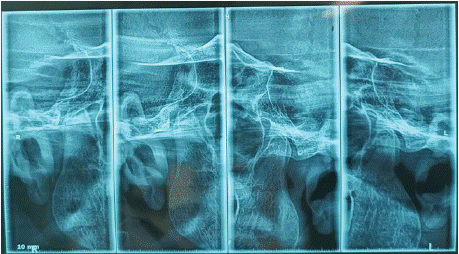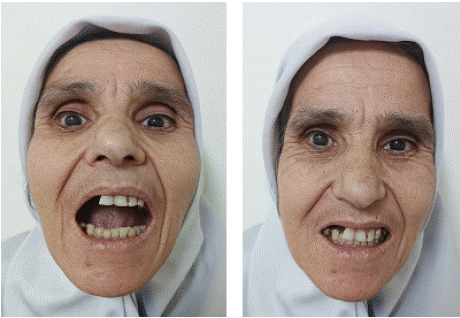
Case Report
Austin J Clin Case Rep. 2025; 12(2): 1354.
Neglected Dislocation of the Temporomandibular Joint: A Case Report
Boukhlouf O*, Benwadih S, Azgaoui A, Dani B and Boulaadas M
Maxillofacial Surgery and Stomatology Departement, Specialties Hospital, Rabat, Morocco
*Corresponding author: Oumaima Boukhlouf, Maxillofacial Surgery and Stomatology Departement, Specialties Hospital, Rabat, Morocco Email: boukhloufoumaima@gmail.com
Received: June 11, 2025 Accepted: July 16, 2025 Published: July 18, 2025
Introduction
The temporomandibular joint can be subject to dislocation in a number of ways. One of them is the neglected dislocation, in which the mandibular condyle is permanently outside the mandibular fossa, most often in front of the temporal condyle, leading to the formation of a neoarticular joint over time.
The resultant deformity and disability caused by dislocation of the jaw, almost invariably causes the patient to seek treatment. It is unusual, therefore, to find a patient with a long-standing dislocation of the jaw [1].
Case Presentation
We report here the case of a patient aged sixty years old who consulted us for a 2 cm mouth opening limitation with a permanent complete gap that had been evolving for a year with difficulty in eating.
Clinical exam revealed no particular pain, nor any notion of subsequent recurrent dislocation, nor any factor or illness, nor any medication that might have triggered it.
TMJ radiology revealed an anterior dislocation of the mandibular condyles, more marked on the right, with vacuity of the mandibular fossae (Figure 1).

Figure 1: Mouth/open mouth/closed mouth X-ray of the TMJ showing
vacuity of the mandibular fossa.
Since subsequent attempts at manual reduction proved unsuccessful, we opted for surgical treatment. The approach was pretragal extended into the temporal region, with resection of the fibrous tissue occupying the mandibular fossa, a discectomy with the creation of a Dautrey bone block held in place by a mini screwplate after reintegration of the mandibular condyles. At the end of the operation, the mouth opening was plus or minus 3.5 cm, with good dentodental articulation. A bi-maxillary block was also applied for 3 weeks to prevent early recurrence.
At 1 year follow-up, there was no evidence of dislocation, although a slight limitation of mouth opening to 3.5cm with restricted lateral movements persisted, and the patient is currently undergoing rehabilitation (Figure 2).

Figure 2: Results at 1 year post-surgery.
Discussion
Neglected TMJ dislocation is a rare and controversial condition in terms of definition, pathogenesis, clinical course, diagnosis and, above all, management.
There are many etiopathogenic factors which may favour the development of a TMJ luxation that have been widely described [2-7].
One of the primary issues with neglected TMJ dislocation is the variety of etiopathogenic factors that may contribute to its development. The condition can be triggered by a range of predisposing factors, which include myotonic and neurological disorders such as Huntington’s disease, epilepsy, Parkinson’s disease, and muscular dystrophies. These conditions interfere with normal muscle function and often lead to the prolonged dislocation of the TMJ. In addition, certain dystonias like Steinert’s disease or Meige’s syndrome, and even prolonged intubation during critical care, have been identified as contributing factors [2]. The resulting TMJ dislocation may initially present as an acute episode, but if left untreated, it can become recurrent or chronic over time.
The chronicity of the condition is exacerbated by the continuous dislocation of the TMJ, which leads to structural changes within the joint itself. The dislocated condyle causes muscle spasms and fibrotic changes in the surrounding soft tissue. Over time, this soft tissue can grow into the glenoid fossa, further complicating the reduction process [4].
As the dislocation persists, it becomes increasingly difficult to reposition the condyle into its correct anatomical position. During this time, a new mandibular fossa forms as the body adapts to the displaced condyle. This is precisely what occurred in our case, where the dislocation went untreated for an extended period.
Neglected dislocations are typically harder to diagnose because of the patient's ability to adapt, which may allow them to function with a displaced condyle without significant immediate pain or dysfunction. However, as the dislocation becomes chronic, the longer it remains untreated, the more difficult it becomes to reduce the condyle and restore normal joint function [1].
Chronic dislocation of the temporo-mandibular joint (TMJ) occurs when an acute dislocation is left untreated, in certain situations, including severe illness, neurologic or psychiatric diseases or prolonged oral intubation.Chronic TMJ dislocations are often the result of neglecting an acute dislocation or treating it inappropriately [8].
Neglected dislocations become progressively irreversible, often requiring surgical reduction [9].
surgical treatments include repositioning of the condyle by direct approach to the TMJ and glenoid evidentiation, resection of the temporal articular tubercle (Myrhaug technique), condylotomy,and condylectomy…[4].
The Dautrey procedure is a preventive procedure that aims to limit anterior displacement of the mandibular condyle by increasing the height of the temporal articular tubercle. It has been found to be very satisfactory in the treatment of recurrent dislocation, and it does not adversely affect joint function [6].
Proper fixation is important to prevent recurrence of longstanding dislocation especially for edentulous patients [4].
Conclusion
Neglected TMJ dislocation is a complex and multifaceted condition that remains challenging in terms of its definition, diagnosis, and management. Early recognition and proper management are crucial in minimizing long-term complications and improving outcomes, particularly for those with recurrent dislocations or edentulous patients.
References
- Chin Roger S, Henning Gropp and O Ross Beirne. “Long-standing mandibular dislocation: report of a case.” Journal of oral and maxillofacial surgery. 1988; 46: 693-696.
- Arzul L, et al. “Luxation chronique bilatérale des articulations temporomandibulaires et syndrome de Meige.” Revue de Stomatologie, de Chirurgie Maxillo-faciale et de Chirurgie Orale. 2015; 116: 106-110.
- Cuevas Queipo de Llano, Alberto, et al. “Long-Term Dislocation of the Mandible: Is there an Algorithm to Success? Intraoperative Decision and Review of Literature.” Journal of Maxillofacial and Oral Surgery. 2020; 16: 12-16.
- Huang IY, et al. “Management of long-standing mandibular dislocation.” International journal of oral and maxillofacial surgery. 2011; 40: 810-814.
- Monje Gil F. Surgical management of temporomandibular joint: vol. 2 open joint surgery, 1st edn. iTunes Store. 2014.
- Srivastava D, Rajadnya M, Chaudhary MK, Srivastava JL. The Dautrey procedure in recurrent dislocation: a review of 12 cases. Int J Oral Maxillofac Surg. 1994; 23: 229–231.
- Gu¨ven O. Nearthrosis in true long-standing temporomandibular joint dislocation; a report on pathogenesis and clinical features with review of literature. J Craniomaxillofac Surg. 2019; 47: 945–950.
- Klu¨ppel LE, Olate S, Serena-Gomez E, De Moraes M, FernandesMoreira RW. Efficacy of eminectomy in the treatment of prolonged mandibular dislocation. Med Oral Patol Oral Cir Bucal. 2010; 15: e891–894.
- Baur DA, Jannuzzi JR, Mercan U, Quereshy FA. Treatment of long term anterior dislocation of the TMJ. Int J Oral Maxillofac Surg. 2013; 42: 1030– 1033.